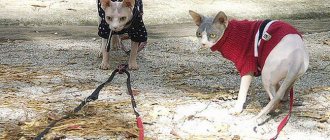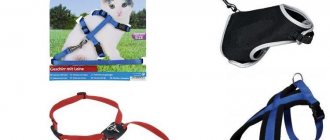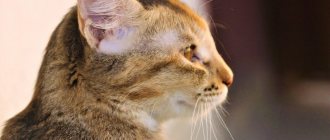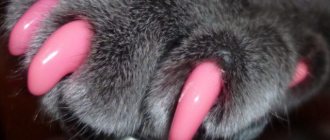Advantages and disadvantages of leashes
Pros:
- Carrying out walks, knowing that the animal will not run away;
- Control over your pet, the ability to avoid hard-to-reach or dangerous places, exclusion of unwanted situations (meeting stray dogs and cats);
- The risk of losing an animal is significantly reduced. He is constantly in sight, which will prevent him from eating anything on the street, jumping into garbage cans, and so on;
- Adjusting the distance between the owner and the pet;
- Just for the peace of mind of the owner himself.
Minuses:
- Not all cats quickly get used to leashes. They may panic, try to break free and run away, and in an agitated and nervous state, the cat may harm itself;
- Incorrectly chosen leashes injure animals, severely squeezing the neck;
- Poor quality leashes can break at any time, and it is possible that the cat, taking advantage of this, will run away and get lost.
We're going for a walk
There are two ways to teach dressing, both using the method of positive associations. Screaming and violence will only undermine the pet’s trust.
Treat your purr to his favorite food when you put on his harness or engage him in play. The cat will get used to the smell and learn that it is rewarded when it is dressed. Then the time of contact with the ammunition is extended.
When the cat behaves calmly, without showing anxiety or trying to remove the harness, and stays in it for a long time, you can get ready to go outside.
The first walk always takes place in uncrowded places, with a minimum number of distractions. The cat can be taken outside in a carrier.
Don't pull on the leash to get him out of her. Offer a treat if the animal refuses to eat or play - it means it is stressed. Wait a while, if the condition does not change, then for the first time it is enough.
Cats, cats, kittens - have their own character, fears, and are subject to mood. Be patient and it will be rewarded. There is nothing better than a carefree walk in the company of a purring dog.
When not to use a harness
- Walking an old cat that is not leash-trained can be a stressful situation for her, which will negatively affect her health;
- A harness for walking a small kitten requires careful selection due to its rapid growth;
Harnesses are not recommended for pregnant cats, or after surgical procedures, or for cats with physiological defects.
Purpose of collars
Collars are purchased in particular for anti-parasitic purposes, as well as in case the animal gets lost or something happens to it. A medallion is attached indicating the cat's name, owner's phone number or address.
Types of harnesses
The essence of cat leashes is to attach the leash to straps that go around the cat's body, which allows you to do without a collar.
They differ in mounting methods:
- Eights. They consist of a pair of loops that are attached to the neck and front legs;
- Vests (jackets). Simple clothes with a leash. Used more often in cool weather. They are made from various materials and decorated in different ways.
- H-shaped. Similar to the figure eight, only the loops on the back are connected using a cross bar.
- V-shaped. The loop in the pet’s chest area looks like the letter “V”, but there are no fundamental differences.
- Y-shaped. Accordingly, the loops are in the shape of the letter “Y”.
How to choose a harness for your pet
The first criterion is the size of the product. Before choosing a harness for your cat, you need to take measurements. To do this, just find out the girth of the neck and chest. All models must indicate the size of the product, so it is not necessary to take your pet with you to the store.
The second criterion is the material of the product. The best option is nylon. This material is lightweight, washes well, and does not lose its appearance or color even after several washes. There are a huge number of nylon harnesses on sale in different models and colors.
The third criterion is the width of the straps. You should not choose a harness made of thin straps. Models with strap widths of at least 1-1.5 cm are more comfortable.
Recommendations for choosing leashes and harnesses
There are two types of leashes: a belt of a given length and a tape measure. The specified length is determined by the activity of the animal. It is used in cases where the pet is timid and when walking in familiar places.
Roulettes are great for walking freedom-loving animals, and the owners themselves will not follow them around, adjusting the required length.
When choosing a leash, you need to take into account its quality (it should not tear), not consisting of a very dense and hard material (the most popular is natural, artificial leather or tarpaulin with different decor and color); the optimal length is 2-2.5 m.
When buying a harness, it would be ideal to take your pet with you, but if this is not possible, you should consider the following nuances:
- Dense, but not rough material, easy to wipe off (nylon, does not rub and fits well to the cat’s body; cotton for older animals with little activity, and for the delicate and sensitive skin of pets, a felt or fleece lining is suitable). Do not use leather products due to heavy weight, chafing and inconvenience to use.
- The width of the straps should ideally be one and a half centimeters, since wider widths will restrict the cat’s movements, and narrow ones usually rub and tighten.
- Fastenings should be easy to fasten and unfasten to ensure durability and high quality to prevent them from breaking.
- The presence of a mechanism for attaching to a leash.
When purchasing a harness without a pet, it is advisable to take his measurements in advance.
If purchased together with a “mustachioed” one, you need to try on the models you like. You can determine whether it fits or not by inserting two fingers between the back of the animal and the strap. When the fingers pass freely, it becomes clear that this model has been chosen correctly.
There are models specially made to make the cat look stylish and beautiful (the presence of rhinestones, pendants, ornaments). Here you need to be careful, as they are more suitable for performing animals in front of the public, participating in exhibitions, and not for ordinary walks, where they can only create inconvenience.
Top-Rating “harnesses for cats”
Remember that your cat may require several options of harnesses and leashes, especially if you raise it from an early age. Options for kittens and adult cats should be considered.
We will look at the five best options for cat harnesses and leashes that you can purchase today through online stores. Here are some of the more suitable harnesses and leashes for Bengals and other cat breeds that will be perfect for your pet. These are some of the highest quality materials suitable for any budget.
TRIXIE cat harness with premium nylon leash
Adjustable premium nylon harness for cats, Trixie. Quick and easy to put on and close thanks to the special locking mechanism. Harness with metal inserts and plastic buckle. Available in various color options.
Set Darell leash and harness double-layer for cats
The main feature of the harness is that the load from the animal’s neck during active movement is transferred to the body, which does not cause the so-called suffocation effect.
DARELL AERO harness with leash for small animals
The line of universal Darrell-AERO harnesses with a bell on a leash with a carabiner is available in eight sizes - suitable for walking a wide variety of pets: rats, guinea pigs, squirrels, ferrets, rabbits, kittens and cats, puppies and small breed dogs. The harness is sewn from a voluminous 3D mesh of different colors, edged with a strong but elastic braid, and can be adjusted according to the girth of the chest and neck using Velcro and fastex connections (plastic snap). The leash is equipped with an elastic shock absorber and a carabiner. The tests carried out revealed a large margin of safety (more than 25 kg for the break of the leash and more than 50 kg for the break of the harness). The harness is easy to wash and dries quickly.
Soft harness with leash Ferplast Jogging Large for rabbits and cats
Jogging is an adjustable nylon harness, specially designed so that you can take your little pet with you. It has a convenient Velcro fastener in order to accurately fit the size of the animal. The photo is for demonstration purposes only, the color of the product may differ from that shown.
Premium Pet Japan anatomical harness with leash
Safe: a carabiner with rotation around an axis prevents twisting. The anatomical shape prevents it from slipping out of the harness.
Comfortable: fits tightly and softly to the body, does not rub. A delicate lining on the reverse side protects the wool from tangles. Mixed fabric allows you to keep warm in winter and avoid diaper rash in summer.
The need for a cat harness
Cats have interesting skeletal structures, for example their collarbones are considered "free-floating", meaning that if their head can fit through some space, so can the rest of their body.
This means that cats have a flexible, rubber-like body that requires strapping to prevent the head from being loose—a top priority—and to restrain the midsection without applying too much pressure when strapped down.
If you are a beginner and have never planned to take your cat for a walk, you may of course be wondering, why buy a cat harness ?
More than 3.2 million cats worldwide enter shelters every year. A leash harness can prevent your cat from getting lost, preventing your cat from running away and having the chance to spend the rest of her days outside.
For example, if you are going on a trip and you may need to take your furry friend with you, a harness or leash can help solve this problem so that your cat can go outside without causing you to worry about running away.
How to use cat harnesses
Harnesses and leashes are protective devices with a series of straps or buckles that wrap around your cat's neck and torso. To produce cat harnesses for escape protection purposes, the manufacturer must provide the following:
- The cat's head, around the collarbone, should be firmly secured, preventing the cat from escaping head first.
- The torso is securely secured over the abdomen to prevent injury.
- The materials used must be flexible but strong enough to resist tearing.
To use a harness for your pet, simply follow the instructions for putting the harness on your cat, fastening all the elements around it in such an order that your cat will eventually love the harness and leash. There is a chance that she will not fall in love with the harness and leash the first time. There are several ways to curb your pet.
How to train a cat to wear a harness
The best time to train your cat to use a leash is when they are kittens, but adult cats can be trained to walk on a leash, too. Just be patient.
We would like to share secrets on how to train a cat to wear a harness, which you can use during training.
1. Introducing Harnesses Don't take your new harness out of the package and put it on your cat right away - this is a sure way to make your cat fear the harness in the future.
Start by simply leaving the harness in areas where your cat usually eats, sleeps or plays. She will feel safe in her own environment. Then, hand the harness to your cat and let her explore and smell it. If your cat loves treats, use treats during training.
Some cats are afraid of the noise that certain types of Velcro and buckles make. As you introduce the restraints, practice making noises so that your pet gets used to the sounds.
If your cat is scared, take steps to calm her down and try again later, another time.
2. How to put a harness on a cat It's time to try putting a harness on your cat. Try to distract her with a treat so that in the future the cat will trust the harness.
Put the harness on your cat, but don't fasten the straps right away. Once the harness is loose, do something else she likes. You can play with your cat or do it closer to food so your cat associates the harness with a positive experience.
Next, fasten the leash before taking your cat out for a walk. Make sure you can comfortably fit two fingers under the collar of the harness (no more, no less). This will ensure that your kitten is comfortable, but also that he won't run away when you go outside!
If your cat begins to “roll over” or refuses to move at all, this is completely normal. Unfasten the leash for a few minutes, or remove the harness completely. Repeat the procedure during the day. Do this every day, each time increasing the time the cat is in the harness until your cat gets used to it.
3. Add a Leash A leash is another strange object that your cat will have to get used to.
As soon as your cat walks normally in a harness, try hooking the leash and let your cat walk around the apartment or house. Try letting the leash trail the cat, but keep in mind that some cats may be scared.
Once your cat is roaming freely, try picking up the leash and following your cat wherever she goes. Continue praising your cat as you walk around, and offer more treats if you feel it is needed.
The last step is to gently guide your cat to the side on the leash and watch how she reacts. If your cat responds when you lead in the direction you want, give them a treat. During this time, watch your cat closely to see if she shows signs of escaping. If the cat responds positively, praise with a treat.
Repeat this step for a few days until your cat no longer notices you attaching a leash and leading her around the house.
4. Going outside Before you take your cat outside, make sure that she has all the necessary vaccinations, vaccines, and that the cat is protected from fleas and ticks.
This is an important step for cats who have never been outside before. You will both be on high alert the first time you go outside, so be careful and pay attention to how your cat reacts to the outdoors.
Try taking your kitten outside and placing him on the ground in an open, quiet place. Your cat may start walking right away. If not, then everything is fine. Be patient and give it time - they may not walk at all on the first day.
After a few days, try to walk your cat the same way you did in the house. Don't expect your cat to walk like a dog. They love to sniff, explore and relax. Let them do these things as this is what they would do in the wild.
Don't push your cat out of their comfort zone, and you should both have some fun outside.
While most cats enjoy being outdoors frequently, keep in mind that your cat may feel uncomfortable while on a leash. You should never force or pull your cat on a leash if it doesn't want to go somewhere.
How to calm a cat while walking
You've seen funny videos of cats, our furry friends, acting weird, but their behavior can be even weirder when on a leash.
If you're worried about how to prevent this or how to calm your cat, here are some tips.
- Use essential oils or soothing scents;
- Bring your cat back into or near your home before removing the harness/leash;
- Move slowly, refraining from pulling on the leash;
- If your cat continues to refuse to go on walks, it may be a sign that you need to be a lot more patient and spend more time. Or try a different harness model.
Should you walk your cat on a leash?
This is a good question to answer. Considering that a cat is not walked as often as a dog, the differences between walking a cat and a dog are significant:
- Cats have no experience of walking in a harness and on a leash;
- Most people walk their dogs, potentially posing a threat to your cat;
- Cats' instincts work differently, and their alarm calls are much more difficult to read.
There are many more publications on how to properly walk a dog than on cats. This means that if you are interested in putting a harness on your cat and getting her outside, you need to do a lot of research.
For example, cats not only purr when they are happy, they sometimes purr when they are in trouble. Another unusual thing is the biological clock for cats. Cats are crepuscular, meaning they are most active before sunset and just after sunset.
Why is this special?
Most people are not aware of the many behavioral factors that can influence cat behavior while walking. For example, your cat may purr when using a harness, for example, and this may be due to pain in your pet.
Also, since cats are crepuscular, you may not be able to get your cat to go out during the midday, simply because they are not in an active state. State of sleep.
If you are interested in taking your cat for a walk, first make sure you understand her behavior.
Correctly putting a leash on a cat
Walking pets without a leash or identifying marks is a very irresponsible act and unsafe for them. But not every lover of these creatures knows exactly how to put a leash on a cat.
First, the cat is calmed down by caressing and saying friendly words, and allowed to smell the walking device. Dressing itself should be calm so as not to frighten the pet.
Then the harness is put on, throwing one of its loops with a carabiner up, and putting the cat’s paws into the other, followed by adjusting the straps until they fit snugly, but not tightly, around her body.
Lastly, fasten the leash to the ring and check that all fastenings are secure.
Belts
The harnesses from the belts are different. Figure-of-eight type made of two rings, with fastening between the shoulder blades. One is worn around the neck, and the other is fixed on the torso.
There are options with straps crossing across the chest to reduce pressure on the throat if the mustachioed person pulls too hard on it.
Or a connecting strap on the back. Their advantage is that they can always be adjusted to suit the age and changing weight of the animal.
A large number of fastenings and belts creates the impression of a complex structure. Do not worry. You can assemble a harness for a walk in a couple of seconds, you just need to practice properly, not on a cat. Only once you get the hang of it, begin to accustom your animal to it.
Leash training a cat
You need to get used to it gradually, first by walking the cat on a leash at home. Observe her reaction, take your time and give her time to get used to the leash. To do this, for example, they leave it in the pet’s favorite places.
The next step is to put on the harness. Having tried to do this, look at the behavior of the animal (aggressive or overly frightened), then you need to postpone the attempts and repeat them later again.
- The most suitable age to begin the adjustment period is from 3 months to 1 year.
- The older the animal is, the more difficult and slower the addiction will be.
Rules for the first walk
On the first walk down the street, it is recommended to pick up the cat and carry it to a quiet, secluded place where there are no people, dogs and cats, and then let it land. Perhaps the cat will not move for some time, carefully examining everything around it.
There is no need to rush her, let her decide for herself when to move on. At the same time, it is necessary to provide conditions where nothing will scare the animal, otherwise the pet will not want to go outside for a long time.
Making a leash at home
You can do without buying it in a store by making your own cat leash at home using a long strip of thick fabric, scissors and a ring with a carabiner.
- A strip of fabric is folded in half lengthwise, stitched with thick thread, and the cut ends are folded over, securing them securely.
- Then a palm loop is made at one end, and a ring with a carabiner is firmly secured at the other.
Here is one way to make a leash for a cat without resorting to buying it in stores.
What to use a leash with?
You can use a cat leash either with a harness or with a collar. Representatives of the cat family are quite freedom-loving by nature. And if the owner forces you to walk on a leash with a collar, the animal will most likely resist. During resistance, the pet may jump out of the leash. To avoid this, you will have to tighten the device more tightly. And this has an extremely negative effect on blood flow. And it will be uncomfortable for the fluffy beauty to walk. The only correct way out in such a situation is to use a leash together with a harness.











